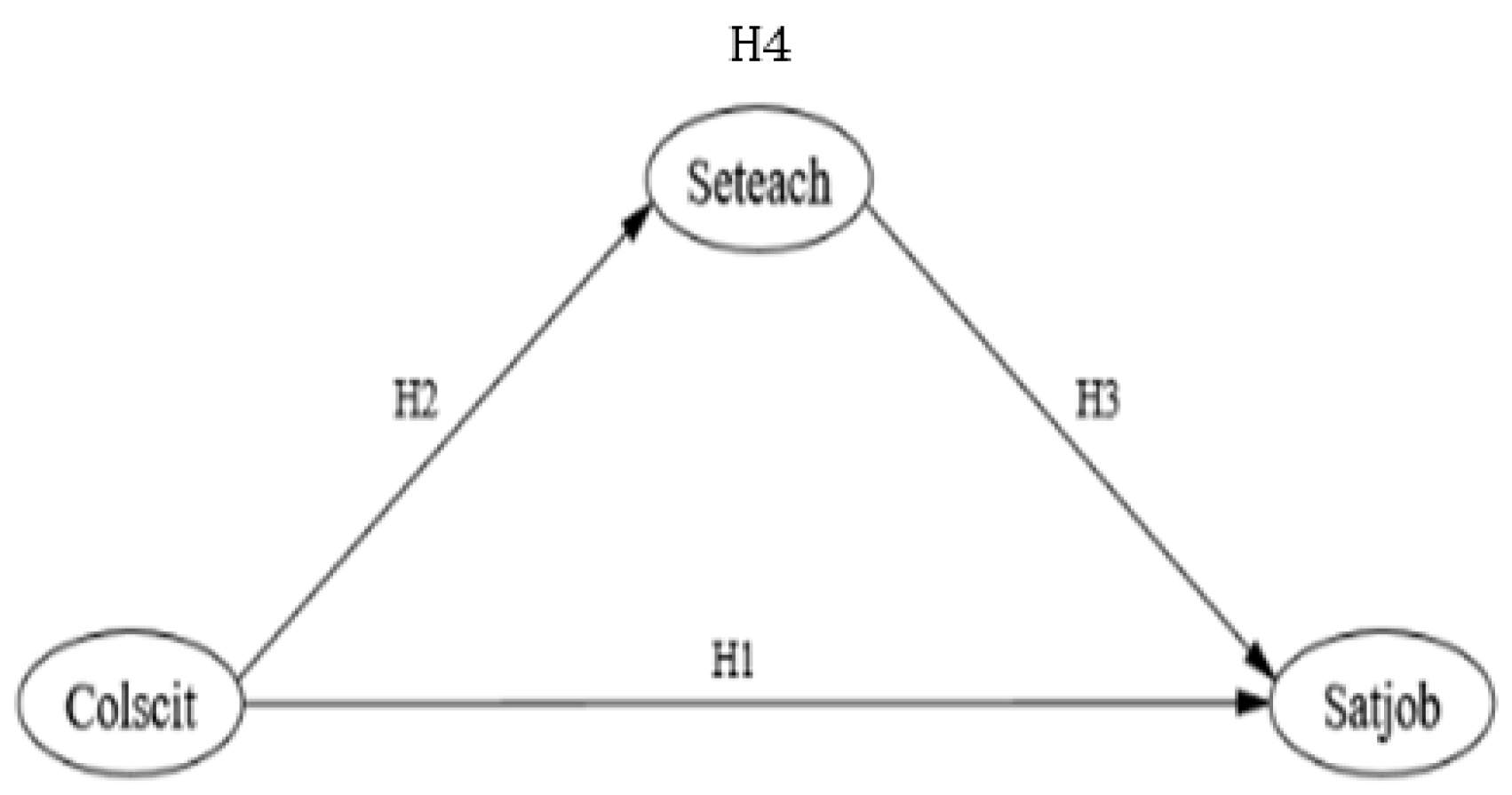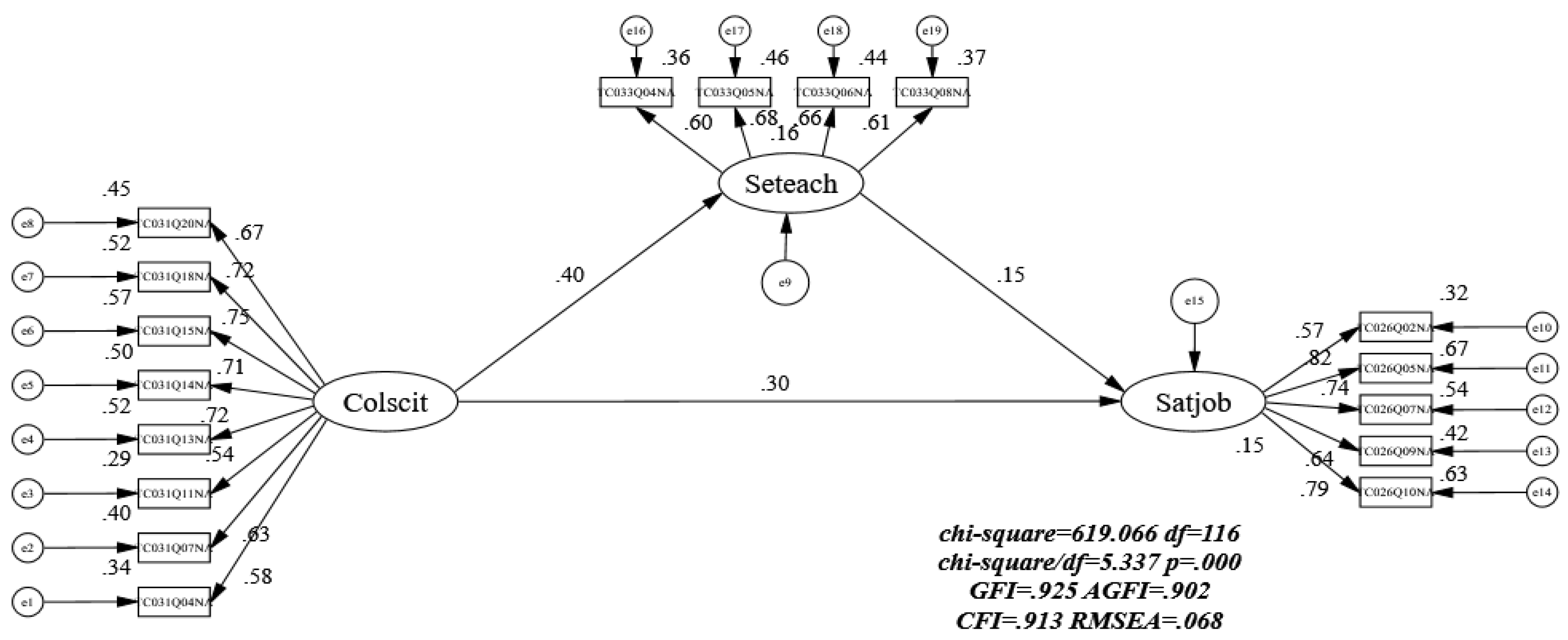1. Introduction
The frequent resignation of teachers has become a common phenomenon recently. Researchers are concerned about this situation. As an example, Parker et al. [
1] indicate that in the United States, teachers were most likely to quit within the first three years of employment. According to statistics, there is an attrition rate of up to 45 percent in the organization. This is arguably astonishing. One might therefore reflect on the need to consider what catalyzes such a high attrition rate. The same situation also exists in China [
2]. It is well known that teachers are one of the most important resources for school development, and ensuring teacher development and stability is crucial to ensuring that the quality of education and teaching is improved as well as an important support for achieving quality and balanced education and sustainable development. There is no doubt that teachers, as the main implementers and participants in the education and teaching process, will play a direct role in influencing a student’s development in a positive way. Therefore, teacher job satisfaction is one of the most important indicators of teachers’ professional well-being, and an important basis for measuring the effectiveness of school management. On the other one hand, over the long term, teachers’ isolation negatively impacts their teaching self-efficacy and their ability to perform well at work [
3,
4,
5,
6]. Fortunately, teacher collaboration can mitigate the negative effects of teacher isolation [
7,
8].
In recent years, teacher-professional collaboration and teaching self-efficacy have received significant attention in academic research. Various empirical studies were conducted in this field [
9,
10,
11,
12]. Teacher professional collaboration is reported to be positively correlated with job satisfaction [
13,
14,
15]. As for teaching self-efficacy, research has demonstrated that teachers who have higher teaching self-efficacy tend to obtain higher confidence in, and greater satisfaction with, their teaching [
16,
17]. Teachers would feel satisfied when they have higher teaching self-efficacy and peer collaboration in teaching. Meanwhile, teacher professional collaboration can reduce isolation and improve teaching self-efficacy. This indicates that teacher professional collaboration has an indirect effect on job satisfaction through teaching self-efficacy.
Science and technology are extremely important to a country and are related to the future and destiny of a country. PISA 2015 focused on investigating students’ science literacy and also focused on science teachers as a group [
18]. On the basis of the literature review which was conducted, it can be said that most of studies are intended for a large group of teachers. On the subject of science teachers, there has been a dearth of research that focuses specifically on the job satisfaction of science teachers. Therefore, in this study, we analyze 1039 teachers’ job satisfaction levels in Hong Kong, China, based on data collected from the PISA 2015 teacher survey. Our research goal is to explore how science teachers’ professional collaboration affects their job satisfaction.
6. Conclusions and Implications
Research has shown that advocates for teacher collaboration tend to emphasize its potential benefits, which may include increased teacher job satisfaction, improved student achievement, and enhanced teacher confidence [
51]. This study utilized structural equation modeling to examine the effects of science teacher professional collaboration on teaching self- efficacy and job satisfaction and to examine the mediating role of science teaching self-efficacy in this context. It was found by the findings of this study that not only did teacher professional collaboration directly and significantly affect teaching efficacy and job satisfaction, but teacher professional collaboration also affected teacher job satisfaction through the mediator of teacher teaching self-efficacy.
As a result of this study, it was found that professional collaboration among science teachers has a considerable impact on teaching self-efficacy, in line with previous research. For example, some researchers suggest that frequent organization of teachers’ sharing of teaching experiences and cooperative learning can promote teachers’ teaching efficacy. Science teacher job satisfaction was also significantly influenced by teacher professional collaboration. During the 1950s, Frederick Hertzberg proposed the “motivational-health factor theory” [
52]. According to this theory, motivational factors are a group of factors that contribute to worker satisfaction, including a sense of accomplishment from the job, recognition of job performance, interest and challenge in the job itself, and a sense of responsibility in the position. By enhancing professional collaboration among teachers, teachers are more likely to solve complex educational and teaching problems together, feel satisfied with their work and gain a sense of accomplishment. It is beneficial for teachers to receive professional recognition from each other and helps teachers to increase their sense of responsibility through mutual learning and communication. It is through participation in professional collaboration activities that teachers enhance their professional competence and professionalism, improve the quality of their teaching, and receive professional recognition from others that contribute to the high level of satisfaction that teachers have as educators. The collaboration of novice teachers can be particularly beneficial for developing their confidence, thereby reducing brain drain among teachers by allowing them to learn from more experienced colleagues and recognizing that they are not the only ones facing particular challenges [
53]. The Professional Learning Communities in Hong Kong, China, are an example of structured teacher collaboration. Through participating in PLCs, teachers feel more connected to their schools and colleagues [
54]. Teachers are often organized to contribute to the development of national policies and guidelines, identify instructional objectives, collaborate to prepare and improve instruction, organize observation visits, provide feedback to colleagues, and organize activities for teachers outside of the classroom [
55]. It is also noteworthy that there is a common practice among teachers in Japan known as “curriculum research” [
56]. TALIS results further support the finding that there is a difference between the patterns of activities in different countries [
57]. It is evident from all the above discussions that professional collaboration is important for science teachers in order to achieve success.
As a result of the findings of the empirical study, we would like to suggest three points. As a first step entails the establishment of a school institutional environment and a culture of teacher collaboration that is conducive to professional collaboration among science teachers. A friendly collaborative atmosphere among science teachers will enhance teaching self-efficacy, improving students’ science literacy as a result. Second, active professional collaboration activities will enhance teachers’ understanding and grasp of subject matter knowledge. The development of professional cooperation activities can not only enhance teachers’ sense of teaching efficacy, but also improve teachers’ sense of subject knowledge efficacy to a certain extent. According to TPACK theories [
58], teachers in the 21st century need to have comprehensive scientific literacy, which is also applicable to science teachers. Another area of focus is the development of science teachers’ pre-service science knowledge and self-efficacy as teachers of science. A number of relevant studies have shown that teachers’ pre-service teaching efficacy can significantly affect their teaching satisfaction after work [
58]. Therefore, it is especially important and feasible to pay attention to the development of science teachers’ pre-service general competence. Lastly, it is important to mention that professional development has a positive impact on the job satisfaction of science teachers. There is an increasing amount of work pressure being placed upon teachers due to the advent of the fourth industrial revolution. How to resolve this challenge is currently a hot topic of concern in countries around the world. Our study reveals that teacher professional collaboration and teacher teaching efficacy can improve the job satisfaction of science teachers. Our findings are expected to be taken seriously and adopted by relevant policy-making authorities.
This study has several limitations. First, the survey data from PISA 2015 is self-reported, so the relationship between teacher professional collaboration, teacher self-efficacy in teaching, and teacher job satisfaction in this study reflects the teachers’ perceptions rather than objective indicators. Therefore, future research could conduct some synthesis of the use of other methods, such as fieldwork, qualitative data, and experimental design. Secondly, this survey used a cross-sectional survey design, which means we cannot provide evidence to prove the causal relationship between these three variables. Therefore, future research should use longitudinal surveys or interview surveys to explore causal relationships. Thirdly, this study reveals the direct and indirect effects of professional collaboration among science teachers on job satisfaction through the mediating variable of science teachers’ teaching self-efficacy. However, China is vast and there are large regional differences, with significant differences in the development of schools in different regions. Therefore, the sample from Hong Kong in China from PISA 2015 used in this study may not produce results that are representative of the entire country. Therefore, future research should be conducted in other regions of China.








